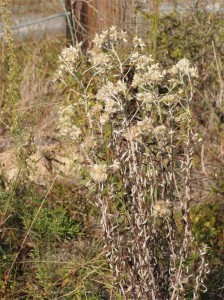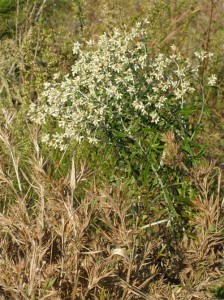An engaging herb, rabbit tobacco
By Ken Moore
One of my favorite native herbs, rabbit tobacco, is an eye-catching wildflower with an engaging aromatic quality. Frequently called sweet everlasting, among countless other names, it retains its wooly white stems and leaf undersides and aromatic qualities for months. Late in the season, the stem leaves turn grayish and take on a lasting curly, dried characteristic.
The ample late-summer rains have been good for this common annual of open fields and roadsides; I’ve enjoyed seeing more of it this year than in the past. And even now in late November, the aging tawny-white seed heads are evident along roadsides.
Its scientific name, Gnaphalium [naff-AY-lium] obtusifolium, from the Greek, gnaphalon, refers to the soft, wooly hairs on stem and leaves. The leaf, -folium, is obtuse, obtusi-, being somewhat rounded at the leaf tip. Now, just to keep some of you taxonomically current, I recently discovered that this plant has been reclassified to Pseudognaphalium obtusifolium.
I’m always intrigued by plants with pseudonyms. I guess rabbit tobacco is not really a gnaphalium, but it’s like a gnaphalium. I’ll leave it to you to ponder its taxonomy.
I’m more intrigued with the common name, the heritage of which I’ve yet to discover. One story is that some Native Americans believed rabbits liked this native herb and were helpful in caring for it in their field habitats.
I presented my question to revered Lumbee herbalist Mary Sue Locklear at the American Indian Heritage Celebration in Raleigh last Saturday. She replied that she had never read or heard a satisfactory explanation, though she enjoys imagining that the bunch of tiny white flower heads resemble the rabbit’s tail, and thus the name. I like her explanation.
She also said there’s nothing better for breaking fevers than a long steeped tea of equal parts dried rabbit tobacco leaves and flowers, green pine needles and green sweet gum leaves. Sweet gum leaves are collected green and dried for use during the winter months.
Earlier Saturday morning at the Carrboro Farmers’ Market, I visited with local herbalist, wildcrafter and teacher Will Endres. Like so many of us, Will also was puzzled about the heritage of the common name; he considers the name a bit demeaning for an herb of such great value. As a digestive bitter, chewing the green leaves is one of nature’s finest herbal aids. Will prefers to use the green leaves.
When asked about smoking rabbit tobacco, Will had a lot to describe. He said it does relieve symptoms of asthma and similar respiratory ailments. He prepares a rabbit tobacco mixture, with other herbs, that is helpful for folks trying to break a smoking habit.
I could have talked with Will Endres and Mary Locklear all day without exhausting the medicinal, ceremonial and spiritual heritage of this engaging plant.
And as for those rabbits – well now, Peter Rabbit was known to enjoy rabbit tobacco tea, though it was most likely a lavender substitute, perhaps the very first “pseudognaphalium.†And then there was Uncle Remus’ Brer Rabbit who “tuck a big char terbacker … you know this life everlastin’ that Miss Sally puts among the clothes in the trunk; well, that’s rabbit terbacker!â€




Comments are closed.